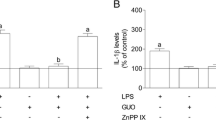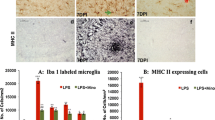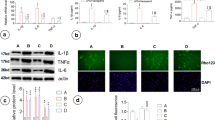Abstract
Sulforaphane is a natural compound that presents anti-inflammatory and antioxidant properties, including in the central nervous system (CNS). Astroglial cells are involved in several functions to maintain brain homeostasis, actively participating in the inflammatory response and antioxidant defense systems. We, herein, investigated the potential mechanisms involved in the glioprotective effects of sulforaphane in the C6 astrocyte cell line, when challenged with the inflammogen, lipopolysaccharide (LPS). Sulforaphane prevented the LPS-induced increase in the expression and/or release of pro-inflammatory mediators, possibly due to nuclear factor κB and hypoxia-inducible factor-1α activation. Sulforaphane also modulated the expressions of the Toll-like and adenosine receptors, which often mediate inflammatory processes induced by LPS. Additionally, sulforaphane increased the mRNA levels of nuclear factor erythroid-derived 2-like 2 (Nrf2) and heme oxygenase-1 (HO1), both of which mediate several cytoprotective responses. Sulforaphane also prevented the increase in NADPH oxidase activity and the elevations of superoxide and 3-nitrotyrosine that were stimulated by LPS. In addition, sulforaphane and LPS modulated superoxide dismutase activity and glutathione metabolism. Interestingly, the anti-inflammatory and antioxidant effects of sulforaphane were blocked by HO1 pharmacological inhibition, suggesting its dependence on HO1 activity. Finally, in support of a glioprotective role, sulforaphane prevented the LPS-induced decrease in glutamate uptake, glutamine synthetase activity, and glial-derived neurotrophic factor (GDNF) levels, as well as the augmentations in S100B release and Na+, K+ ATPase activity. To our knowledge, this is the first study that has comprehensively explored the glioprotective effects of sulforaphane on astroglial cells, reinforcing the beneficial effects of sulforaphane on astroglial functionality.








Similar content being viewed by others
Data Availability
The datasets used and/or analyzed during the current study are available from the corresponding author on reasonable request.
References
Abid MdR, Spokes KC, Shih S-C, Aird WC (2007) NADPH oxidase activity selectively modulates vascular endothelial growth factor signaling pathways. J Biol Chem 282:35373–35385. https://doi.org/10.1074/jbc.M702175200
Aebi H (1984) Catalase in vitro. Methods Enzymol 105:121–126
Aguilera G, Colín-González AL, Rangel-López E et al (2018) Redox signaling, neuroinflammation, and neurodegeneration. Antioxid Redox Signal 28:1626–1651. https://doi.org/10.1089/ars.2017.7099
Allard JS, Perez E, Zou S, de Cabo R (2009) Dietary activators of Sirt1. Mol Cell Endocrinol 299:58–63. https://doi.org/10.1016/j.mce.2008.10.018
Allen NJ, Eroglu C (2017) Cell biology of astrocyte-synapse interactions. Neuron 96:697–708. https://doi.org/10.1016/j.neuron.2017.09.056
Allen SJ, Watson JJ, Shoemark DK et al (2013) GDNF, NGF and BDNF as therapeutic options for neurodegeneration. Pharmacol Ther 138:155–175. https://doi.org/10.1016/j.pharmthera.2013.01.004
Anderson MA, Ao Y, Sofroniew MV (2014) Heterogeneity of reactive astrocytes. Neurosci Lett 565:23–29. https://doi.org/10.1016/j.neulet.2013.12.030
Arús BA, Souza DG, Bellaver B et al (2017) Resveratrol modulates GSH system in C6 astroglial cells through heme oxygenase 1 pathway. Mol Cell Biochem 428:67–77. https://doi.org/10.1007/s11010-016-2917-5
Axelsson AS, Tubbs E, Mecham B et al (2017) Sulforaphane reduces hepatic glucose production and improves glucose control in patients with type 2 diabetes. Sci Transl Med. https://doi.org/10.1126/scitranslmed.aah4477
Bélanger M, Allaman I, Magistretti PJ (2011) Brain energy metabolism: focus on astrocyte-neuron metabolic cooperation. Cell Metab 14:724–738. https://doi.org/10.1016/j.cmet.2011.08.016
Bellaver B, Souza DG, Bobermin LD et al (2015) Guanosine inhibits LPS-induced pro-inflammatory response and oxidative stress in hippocampal astrocytes through the heme oxygenase-1 pathway. Purinergic Signal 11:571–580. https://doi.org/10.1007/s11302-015-9475-2
Bergström P, Andersson HC, Gao Y et al (2011) Repeated transient sulforaphane stimulation in astrocytes leads to prolonged Nrf2-mediated gene expression and protection from superoxide-induced damage. Neuropharmacology 60:343–353. https://doi.org/10.1016/j.neuropharm.2010.09.023
Bobermin LD, Hansel G, Scherer EBS et al (2015) Ammonia impairs glutamatergic communication in astroglial cells: protective role of resveratrol. Toxicol Vitro Int J Publ Assoc BIBRA 29:2022–2029. https://doi.org/10.1016/j.tiv.2015.08.008
Bobermin LD, Quincozes-Santos A, Guerra MC et al (2012) Resveratrol prevents ammonia toxicity in astroglial cells. PLoS ONE 7:e52164. https://doi.org/10.1371/journal.pone.0052164
Bobermin LD, Roppa RHA, Quincozes-Santos A (2019) Adenosine receptors as a new target for resveratrol-mediated glioprotection. Biochim Biophys Acta Mol Basis Dis 1865:634–647. https://doi.org/10.1016/j.bbadis.2019.01.004
Bolaños JP (2016) Bioenergetics and redox adaptations of astrocytes to neuronal activity. J Neurochem 139:115–125. https://doi.org/10.1111/jnc.13486
Bricker GV, Riedl KM, Ralston RA et al (2014) Isothiocyanate metabolism, distribution, and interconversion in mice following consumption of thermally processed broccoli sprouts or purified sulforaphane. Mol Nutr Food Res 58:1991–2000. https://doi.org/10.1002/mnfr.201400104
Browne RW, Armstrong D (1998) Reduced glutathione and glutathione disulfide. Free radical and antioxidant protocols. Humana Press, New Jersey, pp 347–352
Chan KM, Delfert D, Junger KD (1986) A direct colorimetric assay for Ca2+ -stimulated ATPase activity. Anal Biochem 157:375–380
Chen J (2014) Heme oxygenase in neuroprotection: from mechanisms to therapeutic implications. Rev Neurosci. https://doi.org/10.1515/revneuro-2013-0046
Clarke JD, Hsu A, Williams DE et al (2011) Metabolism and tissue distribution of sulforaphane in Nrf2 knockout and wild-type mice. Pharm Res 28:3171–3179. https://doi.org/10.1007/s11095-011-0500-z
Colombo E, Farina C (2016) Astrocytes: key regulators of neuroinflammation. Trends Immunol 37:608–620. https://doi.org/10.1016/j.it.2016.06.006
Corssac GB, Campos-Carraro C, Hickmann A et al (2018) Sulforaphane effects on oxidative stress parameters in culture of adult cardiomyocytes. Biomed Pharmacother 104:165–171. https://doi.org/10.1016/j.biopha.2018.05.031
Dai X, Yan X, Wintergerst KA et al (2020) Nrf2: redox and metabolic regulator of stem cell state and function. Trends Mol Med 26:185–200. https://doi.org/10.1016/j.molmed.2019.09.007
Danilov CA, Chandrasekaran K, Racz J et al (2009) Sulforaphane protects astrocytes against oxidative stress and delayed death caused by oxygen and glucose deprivation. Glia 57:645–656. https://doi.org/10.1002/glia.20793
Donato R, Sorci G, Riuzzi F et al (2009) S100B’s double life: intracellular regulator and extracellular signal. Biochim Biophys Acta 1793:1008–1022. https://doi.org/10.1016/j.bbamcr.2008.11.009
dos Santos AQ, Nardin P, Funchal C et al (2006) Resveratrol increases glutamate uptake and glutamine synthetase activity in C6 glioma cells. Arch Biochem Biophys 453:161–167. https://doi.org/10.1016/j.abb.2006.06.025
Dwivedi S, Rajasekar N, Hanif K et al (2016) Sulforaphane ameliorates okadaic acid-induced memory impairment in rats by activating the Nrf2/HO-1 antioxidant pathway. Mol Neurobiol 53:5310–5323. https://doi.org/10.1007/s12035-015-9451-4
Feng S, Xu Z, Wang F et al (2017) Sulforaphane prevents methylmercury-induced oxidative damage and excitotoxicity through activation of the Nrf2-ARE pathway. Mol Neurobiol 54:375–391. https://doi.org/10.1007/s12035-015-9643-y
Fernandes RO, Bonetto JHP, Baregzay B et al (2015) Modulation of apoptosis by sulforaphane is associated with PGC-1α stimulation and decreased oxidative stress in cardiac myoblasts. Mol Cell Biochem 401:61–70. https://doi.org/10.1007/s11010-014-2292-z
Fernandes RO, De Castro AL, Bonetto JHP et al (2016) Sulforaphane effects on postinfarction cardiac remodeling in rats: modulation of redox-sensitive prosurvival and proapoptotic proteins. J Nutr Biochem 34:106–117. https://doi.org/10.1016/j.jnutbio.2016.05.004
García-Cáceres C, Balland E, Prevot V et al (2019) Role of astrocytes, microglia, and tanycytes in brain control of systemic metabolism. Nat Neurosci 22:7–14. https://doi.org/10.1038/s41593-018-0286-y
Gessi S, Merighi S, Stefanelli A et al (2013) A1 and A3 adenosine receptors inhibit LPS-induced hypoxia-inducible factor-1 accumulation in murine astrocytes. Pharmacol Res 76:157–170. https://doi.org/10.1016/j.phrs.2013.08.002
Gonçalves C-A, Concli Leite M, Nardin P (2008) Biological and methodological features of the measurement of S100B, a putative marker of brain injury. Clin Biochem 41:755–763. https://doi.org/10.1016/j.clinbiochem.2008.04.003
Gorina R, Font-Nieves M, Márquez-Kisinousky L et al (2011) Astrocyte TLR4 activation induces a proinflammatory environment through the interplay between MyD88-dependent NFκB signaling, MAPK, and Jak1/Stat1 pathways. Glia 59:242–255. https://doi.org/10.1002/glia.21094
Greenhalgh AD, David S, Bennett FC (2020) Immune cell regulation of glia during CNS injury and disease. Nat Rev Neurosci 21:139–152. https://doi.org/10.1038/s41583-020-0263-9
Guerra M, Tortorelli LS, Galland F et al (2011) Lipopolysaccharide modulates astrocytic S100B secretion: a study in cerebrospinal fluid and astrocyte cultures from rats. J Neuroinflamm 8:128. https://doi.org/10.1186/1742-2094-8-128
Hanke ML, Kielian T (2011) Toll-like receptors in health and disease in the brain: mechanisms and therapeutic potential. Clin Sci Lond Engl 1979 121:367–387. https://doi.org/10.1042/CS20110164
Haselkorn ML, Shellington DK, Jackson EK et al (2010) Adenosine A1 receptor activation as a brake on the microglial response after experimental traumatic brain injury in mice. J Neurotrauma 27:901–910. https://doi.org/10.1089/neu.2009.1075
Hung S-Y, Liou H-C, Fu W-M (2010) The mechanism of heme oxygenase-1 action involved in the enhancement of neurotrophic factor expression. Neuropharmacology 58:321–329. https://doi.org/10.1016/j.neuropharm.2009.11.003
Jensen CJ, Massie A, De Keyser J (2013) Immune players in the CNS: the astrocyte. J Neuroimmune Pharmacol 8:824–839. https://doi.org/10.1007/s11481-013-9480-6
Lee M, Cho T, Jantaratnotai N et al (2010) Depletion of GSH in glial cells induces neurotoxicity: relevance to aging and degenerative neurological diseases. FASEB J 24:2533–2545. https://doi.org/10.1096/fj.09-149997
Leite MC, Galland F, Brolese G et al (2008) A simple, sensitive and widely applicable ELISA for S100B: methodological features of the measurement of this glial protein. J Neurosci Methods 169:93–99. https://doi.org/10.1016/j.jneumeth.2007.11.021
Li L, Sun Q, Li Y et al (2015) Overexpression of SIRT1 induced by resveratrol and inhibitor of miR-204 suppresses activation and proliferation of microglia. J Mol Neurosci 56:858–867. https://doi.org/10.1007/s12031-015-0526-5
Liddell J (2017) Are astrocytes the predominant cell type for activation of Nrf2 in aging and neurodegeneration? Antioxidants 6:65. https://doi.org/10.3390/antiox6030065
Liu Y, Hettinger CL, Zhang D et al (2014) Sulforaphane enhances proteasomal and autophagic activities in mice and is a potential therapeutic reagent for Huntington’s disease. J Neurochem 129:539–547. https://doi.org/10.1111/jnc.12647
Livak KJ, Schmittgen TD (2001) Analysis of relative gene expression data using real-time quantitative PCR and the 2(-Delta Delta C(T)) method. Methods San Diego Calif 25:402–408. https://doi.org/10.1006/meth.2001.1262
Lowry OH, Rosebrough NJ, Farr AL, Randall RJ (1951) Protein measurement with the Folin phenol reagent. J Biol Chem 193:265–275
Lu SC (2013) Glutathione synthesis. Biochim Biophys Acta 1830:3143–3153. https://doi.org/10.1016/j.bbagen.2012.09.008
Markiewicz I, Lukomska B (2006) The role of astrocytes in the physiology and pathology of the central nervous system. Acta Neurobiol Exp (Warsz) 66:343–358
Merighi S, Borea PA, Stefanelli A et al (2015) A 2a and a 2b adenosine receptors affect HIF-1α signaling in activated primary microglial cells: adenosine receptors in microglial cells. Glia 63:1933–1952. https://doi.org/10.1002/glia.22861
Moriyama M, Kurebayashi R, Kawabe K et al (2016) Acetate attenuates lipopolysaccharide-induced nitric oxide production through an anti-oxidative mechanism in cultured primary rat astrocytes. Neurochem Res 41:3138–3146. https://doi.org/10.1007/s11064-016-2038-2
Newell EA, Exo JL, Verrier JD et al (2015) 2’,3’-cAMP, 3’-AMP, 2’-AMP and adenosine inhibit TNF-α and CXCL10 production from activated primary murine microglia via A2A receptors. Brain Res 1594:27–35. https://doi.org/10.1016/j.brainres.2014.10.059
Niture SK, Khatri R, Jaiswal AK (2014) Regulation of Nrf2—an update. Free Radic Biol Med 66:36–44. https://doi.org/10.1016/j.freeradbiomed.2013.02.008
Palazon A, Goldrath A, Nizet V, Johnson RS (2014) HIF Transcription factors, inflammation, and immunity. Immunity 41:518–528. https://doi.org/10.1016/j.immuni.2014.09.008
Pan H, He M, Liu R et al (2014) Sulforaphane protects rodent retinas against ischemia-reperfusion injury through the activation of the Nrf2/HO-1 antioxidant pathway. PLoS ONE 9:e114186. https://doi.org/10.1371/journal.pone.0114186
Parada E, Buendia I, Navarro E et al (2015) Microglial HO-1 induction by curcumin provides antioxidant, antineuroinflammatory, and glioprotective effects. Mol Nutr Food Res 59:1690–1700. https://doi.org/10.1002/mnfr.201500279
Quincozes-Santos A, Bobermin LD, de Assis AM et al (2017) Fluctuations in glucose levels induce glial toxicity with glutamatergic, oxidative and inflammatory implications. Biochim Biophys Acta BBA 1863:1–14. https://doi.org/10.1016/j.bbadis.2016.09.013
Quincozes-Santos A, Bobermin LD, Latini A et al (2013) Resveratrol protects C6 astrocyte cell line against hydrogen peroxide-induced oxidative stress through heme oxygenase 1. PLoS ONE 8:e64372. https://doi.org/10.1371/journal.pone.0064372
Quincozes-Santos A, Bobermin LD, Souza DG et al (2014) Guanosine protects C6 astroglial cells against azide-induced oxidative damage: a putative role of heme oxygenase 1. J Neurochem 130:61–74. https://doi.org/10.1111/jnc.12694
Rocha SM, Cristovão AC, Campos FL et al (2012) Astrocyte-derived GDNF is a potent inhibitor of microglial activation. Neurobiol Dis 47:407–415. https://doi.org/10.1016/j.nbd.2012.04.014
Rosciszewski G, Cadena V, Murta V et al (2018) Toll-like receptor 4 (TLR4) and triggering receptor expressed on myeloid cells-2 (TREM-2) activation balance astrocyte polarization into a proinflammatory phenotype. Mol Neurobiol 55:3875–3888. https://doi.org/10.1007/s12035-017-0618-z
Ruhee RT, Ma S, Suzuki K (2020) Protective effects of sulforaphane on exercise-induced organ damage via inducing antioxidant defense responses. Antioxidants 9:136. https://doi.org/10.3390/antiox9020136
Ryter SW, Choi AMK (2016) Targeting heme oxygenase-1 and carbon monoxide for therapeutic modulation of inflammation. Transl Res 167:7–34. https://doi.org/10.1016/j.trsl.2015.06.011
Santos CL, Bobermin LD, Souza DG et al (2015) Lipoic acid and N-acetylcysteine prevent ammonia-induced inflammatory response in C6 astroglial cells: the putative role of ERK and HO1 signaling pathways. Toxicol In Vitro 29:1350–1357. https://doi.org/10.1016/j.tiv.2015.05.023
Schousboe A (2019) Metabolic signaling in the brain and the role of astrocytes in control of glutamate and GABA neurotransmission. Neurosci Lett 689:11–13. https://doi.org/10.1016/j.neulet.2018.01.038
Seelig GF, Meister A (1985) Glutathione biosynthesis; gamma-glutamylcysteine synthetase from rat kidney. Methods Enzymol 113:379–390
Sharma N, Nehru B (2015) Characterization of the lipopolysaccharide induced model of Parkinson’s disease: role of oxidative stress and neuroinflammation. Neurochem Int 87:92–105. https://doi.org/10.1016/j.neuint.2015.06.004
Tang L, Ren X, Han Y et al (2020) Sulforaphane attenuates apoptosis of hippocampal neurons induced by high glucose via regulating endoplasmic reticulum. Neurochem Int 136:104728. https://doi.org/10.1016/j.neuint.2020.104728
Tarozzi A, Angeloni C, Malaguti M et al (2013) Sulforaphane as a potential protective phytochemical against neurodegenerative diseases. Oxid Med Cell Longev 2013:415078. https://doi.org/10.1155/2013/415078
Tortorella SM, Royce SG, Licciardi PV, Karagiannis TC (2015) Dietary sulforaphane in cancer chemoprevention: the role of epigenetic regulation and HDAC inhibition. Antioxid Redox Signal 22:1382–1424. https://doi.org/10.1089/ars.2014.6097
Uddin MdS, Mamun AA, Jakaria Md et al (2020) Emerging promise of sulforaphane-mediated Nrf2 signaling cascade against neurological disorders. Sci Total Environ 707:135624. https://doi.org/10.1016/j.scitotenv.2019.135624
Vainchtein ID, Molofsky AV (2020) Astrocytes and microglia: in sickness and in health. Trends Neurosci 43:144–154. https://doi.org/10.1016/j.tins.2020.01.003
Valori CF, Guidotti G, Brambilla L, Rossi D (2019) Astrocytes: emerging therapeutic targets in neurological disorders. Trends Mol Med 25:750–759. https://doi.org/10.1016/j.molmed.2019.04.010
van Uden P, Kenneth NS, Rocha S (2008) Regulation of hypoxia-inducible factor-1alpha by NF-kappaB. Biochem J 412:477–484. https://doi.org/10.1042/BJ20080476
Vargas MR, Johnson DA, Sirkis DW et al (2008) Nrf2 activation in astrocytes protects against neurodegeneration in mouse models of familial amyotrophic lateral sclerosis. J Neurosci 28:13574–13581. https://doi.org/10.1523/JNEUROSCI.4099-08.2008
Villarreal A, Seoane R, González Torres A et al (2014) S100B protein activates a RAGE-dependent autocrine loop in astrocytes: implications for its role in the propagation of reactive gliosis. J Neurochem 131:190–205. https://doi.org/10.1111/jnc.12790
Wakabayashi N, Slocum SL, Skoko JJ et al (2010) When NRF2 talks, who’s listening? Antioxid Redox Signal 13:1649–1663. https://doi.org/10.1089/ars.2010.3216
Wang Y, Zhao C-S (2019) Sigma-1 receptor activation ameliorates LPS-induced NO production and ROS formation through the Nrf2/HO-1 signaling pathway in cultured astrocytes. Neurosci Lett 711:134387. https://doi.org/10.1016/j.neulet.2019.134387
Wyse AT, Streck EL, Barros SV et al (2000) Methylmalonate administration decreases Na+, K+-ATPase activity in cerebral cortex of rats. NeuroReport 11:2331–2334
Yoo BK, Choi JW, Shin CY et al (2008) Activation of p38 MAPK induced peroxynitrite generation in LPS plus IFN-gamma-stimulated rat primary astrocytes via activation of iNOS and NADPH oxidase. Neurochem Int 52:1188–1197. https://doi.org/10.1016/j.neuint.2007.12.009
Funding
This study was supported by the Conselho Nacional de Desenvolvimento Científico e Tecnológico (CNPq), Coordenação de Aperfeiçoamento de Pessoal de Nível Superior (CAPES), Fundação de Amparo à Pesquisa do Estado do Rio Grande do Sul (FAPERGS), Universidade Federal do Rio Grande do Sul and Instituto Nacional de Ciência e Tecnologia para Excitotoxicidade e Neuroproteção (INCTEN/CNPq).
Author information
Authors and Affiliations
Contributions
All authors contributed to the study conception and design. Material preparation, data collection and analysis were performed by LDB, FWB, TMdS and AQS. The manuscript was written by LDB, ABK, ATSW, CAG and AQS and all authors commented on previous versions of the manuscript. All authors read and approved the final manuscript.
Corresponding author
Ethics declarations
Conflict of interest
The authors have no conflicts of interest.
Additional information
Publisher's Note
Springer Nature remains neutral with regard to jurisdictional claims in published maps and institutional affiliations.
Rights and permissions
About this article
Cite this article
Bobermin, L.D., Weber, F.B., dos Santos, T.M. et al. Sulforaphane Induces Glioprotection After LPS Challenge. Cell Mol Neurobiol 42, 829–846 (2022). https://doi.org/10.1007/s10571-020-00981-5
Received:
Accepted:
Published:
Issue Date:
DOI: https://doi.org/10.1007/s10571-020-00981-5




